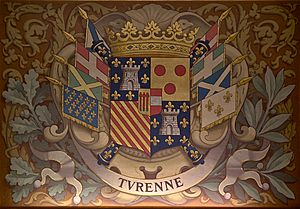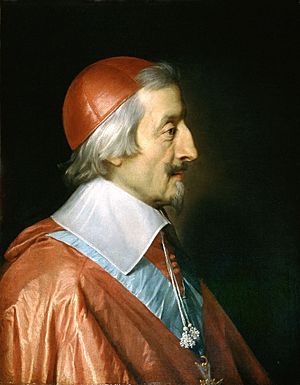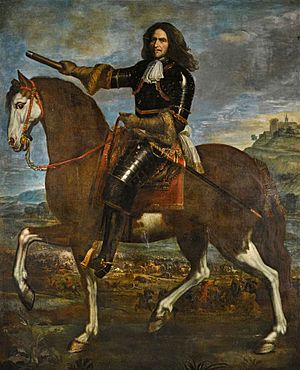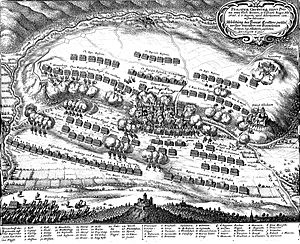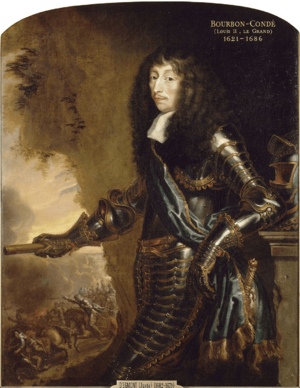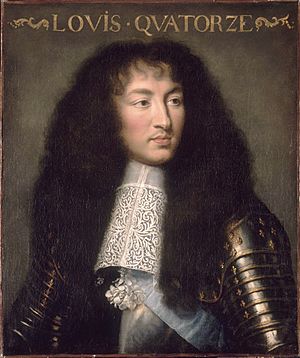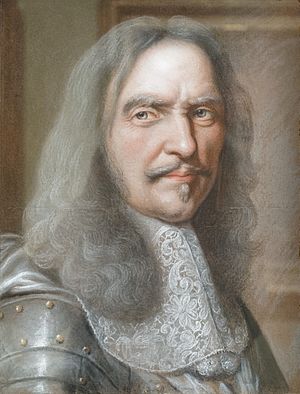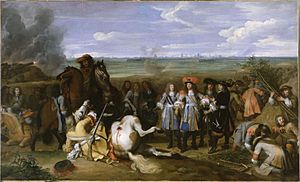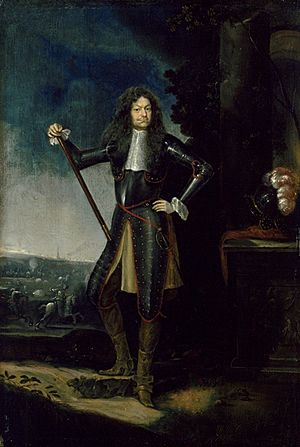Henri de La Tour d'Auvergne, Viscount of Turenne facts for kids
Quick facts for kids
Henri de La Tour d’Auvergne, Viscount of Turenne
|
|
|---|---|
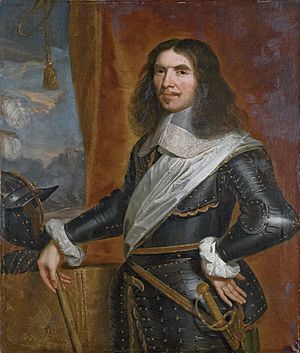
Portrait by Philippe de Champaigne
|
|
| Nickname(s) | Turenne |
| Born | 11 September 1611 Castle of Sedan, Principality of Sedan (present-day France) |
| Died | 27 July 1675 (aged 63) Sasbach, Duchy of Württemberg (present-day Germany) |
| Allegiance |
|
| Service/ |
|
| Years of service | 1625–1675 |
| Rank | Maréchal général des camps et armées du roi |
| Battles/wars |
|
| Signature | |
Henri de La Tour d'Auvergne, Viscount of Turenne (born September 11, 1611 – died July 27, 1675), often called Turenne, was a famous French general. He was one of only six Marshals ever promoted to Marshal General of France. Turenne came from the important House of La Tour d'Auvergne family. His military skills over 50 years made him one of history's greatest commanders.
Turenne was born into a Huguenot (French Protestant) family. His father was also a Marshal of France. This meant Turenne learned about war from a young age. He first served as a volunteer in the Dutch States Army under his uncles. Later, he joined the French army. His noble background and proven skills quickly helped him rise through the ranks. He became well-known during the Thirty Years' War by capturing the strong Breisach fortress in 1638.
In 1643, he became a Marshal of France. The next year, he attacked Bavaria. He defeated the Bavarian army over three years, forcing their leader, the Elector of Bavaria, to make peace. The Elector soon broke the peace treaty. So, in 1648, Turenne invaded Bavaria again with help from Sweden. He defeated the Imperial army at Zusmarshausen and brought peace back to Bavaria.
Turenne first supported a civil war in France called the Fronde. But he returned to serve the King in 1651. He became France's top general by defeating the rebellious army of the Prince of Condé near Paris. He then took back the city. His wins against Spanish armies at Arras (1654) and Dunkirk (1658) helped France take over much of the Spanish Netherlands. This brought the war against Spain to a successful end. Two years later, King Louis XIV made him Marshal General of France. Turenne believed in strong kingship. He became a Catholic in 1668, even though he had refused to do so earlier for political reasons.
During the War of Devolution in 1667, Turenne captured the Spanish Netherlands easily. In 1672, the French invaded the Dutch Republic. Turenne conquered the country almost up to Amsterdam. The Dutch stopped him by flooding their land. The next year, he invaded the Holy Roman Empire. He reached the Elbe River and forced Brandenburg to leave the anti-French alliance. Facing stronger Allied forces in Alsace, he ended his career with many battlefield victories. His most famous wins were at Turckheim (1675) and a brilliant winter march around the Vosges mountains. This march pushed the Imperial forces out of Alsace. Turenne was killed by a cannonball at the battle of Salzbach in 1675.
Contents
Early Life and Military Training
Henri de La Tour d'Auvergne was the second son of the Duke of Bouillon. His mother, Elizabeth, was the daughter of William the Silent, Prince of Orange. He was born in Sedan. People say he gave much of his money to the poor when he was young.
He received a Huguenot (Protestant) education. He also got the usual training for a young noble of his time. Turenne was not very strong and had a speech problem. But he was very good at history and geography. He was especially inspired by Alexander the Great and Julius Caesar. At first, he was a lazy student. But his father told him that his laziness would stop him from joining the army. So, Turenne started to study hard on his own.
After his father died in 1623, he worked on his physical strength. He became much stronger. Turenne and his mother were strong Calvinists. They did not trust Cardinal Richelieu, a powerful French leader. So, when Turenne was 14, he went to study war with his uncle, Maurice of Nassau. Maurice was the leader of Holland. Turenne started as a regular soldier in Maurice's guard during the Eighty Years' War.

In 1626, Frederick Henry of Nassau gave Turenne a captain's rank. Frederick Henry took over from his brother Maurice. Turenne trained his soldiers himself. He earned their respect by being kind and living simply. His company was known as the best trained in the army. He expected his soldiers to be disciplined and have high morals. His kindness made him popular with everyone in the army.
The young officer took part in many sieges (when an army surrounds a city to capture it). He learned a lot about building defenses and siege warfare. He was praised for his skill at the siege of Bois-le-Duc in 1629. But he was also told off for being too reckless. He also learned important details about leading an army, like setting up guards and scouting.
In 1630, Turenne left the Netherlands to join the French army. He wanted to advance his military career. His mother also wanted to show loyalty to the French king.
Rising Through the Ranks
Cardinal Richelieu immediately made Turenne a colonel. Turenne still served with the Prince of Orange sometimes, as the Dutch and French were allies. He fought successfully near Antwerp and against Hendrik van den Bergh. His first major service for France was at the siege of La Mothe in 1634. His great bravery during the attack earned him a promotion to maréchal de camp (like a major-general today).
In 1635, Turenne served in Lorraine and on the Rhine River. The French and their allies lifted the Imperial siege of Mainz. But the French army had to retreat because they ran out of food. During the retreat, Turenne faced the famous Imperial General Gallas. Turenne showed great skill and defeated his pursuers. However, the Imperial army was too large to be stopped completely.
In 1636, the French army regrouped and captured Saverne. Turenne was seriously wounded during the attack. In 1637, he fought in Flanders and helped capture Landrecies. In late 1638, Turenne helped lead the attack on Breisach. This was known as the strongest fortress on the upper Rhine. It surrendered on December 17.
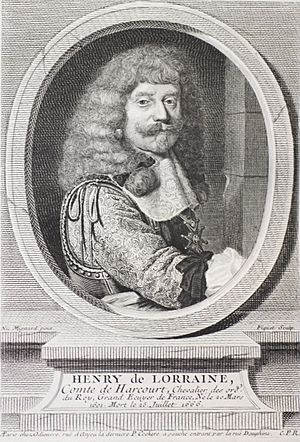
Turenne was now known as one of France's best young generals. Richelieu then sent him to the Italian campaign of 1639–1640. On November 19, 1639, Turenne fought in the famous "Route de Quiers" battle. He received much praise for this, even though he described his own role as small. At the Battle of Casal, 10,000 French soldiers defeated 20,000 Spanish. The French commander, Harcourt, was almost surrounded. But Turenne used a trick to scare off the enemy, and the battle was won.
In 1640, Harcourt saved Casale Monferrato and surrounded Prince Thomas's forces in Turin. Turenne helped resupply the French forces inside the citadel of Turin. The French in the citadel held out, and Prince Thomas had to surrender on September 17, 1640. Turenne, now a lieutenant-general, played a big part in this victory. He commanded forces in 1641 and captured Coni, Ceva, and Mondovì.
In 1642, he was second-in-command of French troops that conquered Roussillon. Around this time, Richelieu discovered a secret plan by Cinq Mars. Turenne's older brother, the Duke of Bouillon, was involved in this plan.
Becoming a Marshal of France
Turenne's family connections affected his early career. Sometimes, his military success helped his family. Other times, his family's actions against Richelieu or Mazarin made the king's advisors not fully trust Turenne. Also, Turenne was a Protestant, which caused more problems with the Catholic ministers.
However, Cardinal Richelieu still gave him command in Italy in 1643. Turenne was under Prince Thomas, who had switched sides and was not fully trusted by Richelieu. Prince Thomas quickly put Turenne in charge of the campaign. Turenne used a trick to make the Spanish weaken Trino, and he captured the town in a few weeks. He was promoted to Marshal of France on May 16, 1643.
Turenne was called back because of Cardinal Mazarin's secret plans to hurt Turenne's career. But this meant Turenne was available when a good commander was suddenly needed. After the French suffered a big defeat at Tuttlingen, Turenne was sent back into action. The next campaign would greatly help his career.
Turenne worked to get the army ready to fight again. He even bought horses for 5,000 cavalry and clothes for 4,000 infantry with his own money. In June 1644, Turenne began campaigning. He crossed the Rhine River at Breisach. He defeated Gaspard von Mercy in the Black Forest before retreating to the Rhine. He could not help the besieged city of Freiburg because he had fewer soldiers.
Soon, a force led by the Duke of Enghien joined him. The Duke, a prince of the royal family, took overall command. The fierce battle of Freiburg against Franz von Mercy's Bavarians happened in August 1644. In this battle, Turenne showed his skill with a well-planned attack on the enemy's side. The French then successfully besieged Philippsburg. Before it surrendered, Enghien left, leaving Turenne in command. Turenne continued by taking the important fortress of Kreuznach.
Turenne started the 1645 campaign well. But Mercy tricked him into thinking the Bavarians were far away. Turenne was surprised and defeated at Mergentheim. One of Turenne's officers did not follow orders, which led to the defeat. Turenne's army lost most of its equipment and soldiers. Turenne retreated to Hesse. Forces from Hesse and Sweden joined the French, along with more soldiers under Condé, who took command again. The Swedes soon left.
The French marched into Bavaria. They faced little resistance until they caught up with Mercy's retreating army. Mercy caused many French casualties with artillery and outsmarted them on the march to Allerheim. This gave him time to strengthen his position. Turenne advised against fighting, but Condé disagreed. Turenne's attack plan was accepted by Condé. The battle was a French victory, and Mercy was killed. But the French suffered heavy losses. Enghien soon left due to illness, leaving Turenne in command for the third time. He faced stronger Imperial forces and was forced to retreat. At Philippsburg, Turenne crossed the Rhine using a bridge made of boats.
A month later, Turenne marched 120 miles to Trier. He recaptured it for its leader after more than ten years of Imperial control. By doing this, he secured the Moselle River for France. Turenne then returned to France. Mazarin tried to cause problems between Turenne and his rebellious brother. He offered Turenne a dukedom that had been promised to his brother. But Turenne saw Mazarin's plan and only accepted if his brother received his promised land first.
In 1646, Turenne had more military successes. He decided to join his forces with the Swedish army under Wrangel. However, Mazarin had made a deal with the Duke of Bavaria not to combine French and Swedish forces and not to cross the Rhine. In return, the Bavarians would not join the Imperial army. Mazarin ordered Turenne to besiege Luxembourg. But Turenne suspected the Duke of Bavaria was playing tricks and delayed. Soon, the Bavarian army joined the Imperials. Turenne then successfully joined Wrangel by taking a detour. The combined army marched down the Danube River and reached Munich. They plundered Bavaria, which convinced the Elector of Bavaria to make peace. Napoleon said Turenne's actions here showed "great boldness, wisdom, and genius." He said they should be studied by all military leaders.

In 1647, Turenne wanted to attack the weakened Imperial army. But he was ordered to Flanders instead. This meant France missed a chance. Also, a serious rebellion broke out among the Weimar troops because they had not been paid for six months. Rosen, an officer Turenne had promoted, convinced the cavalry to revolt. Turenne had left for Flanders, but he rode back with a small group. He surprised the rebels. Instead of attacking them, he marched with them as if he was still in command. He secretly had Rosen arrested, and the rebellion ended.
He then marched into Luxembourg. But he soon received orders to move to the Rhine. As Turenne had predicted, Bavaria joined the Imperial side again in 1647. He forced the Imperials to stop their Siege of Worms and officially declared war on Bavaria. After joining with the Swedes again, led by Wrangel, they moved against the Imperials. Scouts found the Imperials. During the night, Turenne secretly moved his troops close to them. The next day, May 17, the Imperials marched off, unaware of the danger. Their rear guard was caught alone and defeated in a fierce battle at Zusmarshausen.
Afterward, troops destroyed Bavaria with fire and sword until a more secure peace was made. Many writers today blame Turenne for this destruction. But at the time, it was seen as a normal and necessary action. Turenne planned to move into Austria and take Vienna. But the Peace of Westphalia was signed, so this campaign never happened.
The Fronde and King Louis XIV
The Peace of Westphalia (1648) did not bring much peace to France. The country soon entered a civil war called the Fronde (1648–1653). During the first part of this war, Turenne refused to join either side. Mazarin had him removed as army commander, so Turenne fled to the Netherlands. He stayed there until the treaty of Rueil (March 1649) ended the first Fronde war.
Louis, Grand Condé had made many enemies at court, especially Mazarin. This eventually led to conflict. Condé expected great rewards for his military service, which had helped Mazarin. But Mazarin did not think highly of Condé's achievements. Condé had recently become Prince of Condé, gained fame and power, and had strong connections. Now, he and Mazarin were trying to destroy each other.
The second war started when Condé and some of his allies were arrested. Turenne, who was also supposed to be arrested, escaped in time. He held Stenay for the "Princes"—Condé, his brother Conti, and his brother-in-law. Turenne's actions were likely influenced by his love for the Duchess de Longueville. In this war, Turenne suffered one of his few defeats at Rethel (December 15, 1650). But the second conflict ended early the next year. The court party collapsed, and the Princes were released.
Turenne made peace and returned to Paris in May 1651. But trouble soon started again. Condé began another revolt in southern France. In this, the third Fronde war, Turenne and Condé were on opposite sides. Turenne commanded the royal armies. Condé led the Frondeurs and their Spanish allies. Turenne showed the bravery of a young soldier at Jargeau (March 28, 1652). He showed the skill of a veteran general at Gien (April 7). He almost completely ended the civil war in the Battle of the Faubourg St Antoine (July 2) and by taking back Paris (October 21).
Battles Against Spain
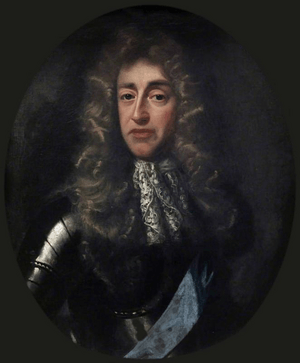
Turenne still had to deal with Condé, who was now fighting with the Spanish. The long campaigns of the "Spanish Fronde" allowed both famous generals to show their military skills. In June 1653, Turenne and La Ferté marched against the Frondeurs. They had about 12,000 to 16,000 soldiers. Condé had 30,000 troops. Turenne heard that the Spanish army was camped in two places far apart. He quickly marched and captured Rethel, which was between them.
Now, a Spanish force of 27,000 soldiers arrived. Turenne decided to follow this force. He wanted to stop it from taking Paris with Condé. He also wanted to limit their actions until winter. The Spanish only planned to take a few forts, so Turenne was successful. At one point, Condé could have defeated Turenne. But the Spanish commander did not allow Condé to attack. The Spanish managed to avoid Turenne and captured Rocroi. While they did this, Turenne took Mouzon and Sainte-Menehould.
Turenne started the 1654 campaign by moving on Stenay. This was a Fronde stronghold and Condé's personal property. Turenne had received more soldiers and prepared strongly to defend against any rescue attempts. Instead, Condé and Archduke Leopold Wilhelm outsmarted him by besieging the important fortress of Arras. Condé and the Archduke had 25,000 troops. Turenne only had 14,000-15,000. So, Turenne decided to wait until Stenay fell before moving against the Frondeurs with full force.
Turenne was not the only commander. The Duke of York, La Ferté, Broglie, and Hocquincourt also had authority. But Turenne convinced them to aggressively deal with the larger Spanish army. Turenne prepared tirelessly for the attack. He personally scouted the enemy positions. He realized the Spanish would take too long to decide whether to attack him. He provided religious services to his troops. He explained to his officers the methods to use against the strong Spanish defenses. The Spanish were completely defeated. They lost 6,000 men and 63 cannons. The French lost only 400 men. This victory was a turning point. From then on, the French had a clear advantage in the region.
Before the 1655 campaign, Turenne had to deal with another important issue. Riots had broken out in Paris. There were also political disagreements between the king and parliament. Civil conflict threatened again. The king forbade parliament from meeting, but parliament ignored this. Mazarin, who was becoming more powerful, invited Turenne to negotiate. Turenne succeeded in resolving the issues.
Turenne started the 1655 campaign by taking Landrecies. Soon after, Turenne almost captured Condé. But a mistake by one of his officers allowed Condé to escape. Turenne then took the fortresses of Condé and St. Guislain. He was then called back to the court at Compiègne. Hocquincourt had lost his important position because of Mazarin. Condé approached him. If Hocquincourt surrendered Ham and Peronne, which he controlled, the French position would be much weaker. Turenne could not move troops there because of the Spanish army. But he convinced Mazarin to negotiate with Hocquincourt, which worked.
At this point, Oliver Cromwell's England and Lorraine, which had been Spain's ally, joined the French side. Philip IV of Spain replaced his unsuccessful commanders with veteran leaders. In June, troops under Turenne and La Ferté surrounded Valenciennes, starting its siege. The Spanish broke nearby dikes to flood Turenne's position. But Turenne had the water redirected to flood part of the city. Turenne saw the Spanish preparing for an attack. He ordered his troops to get ready for an afternoon or night attack. But La Ferté did not follow the order. So, when the Spanish attacked, his position was overrun in just 15 minutes. La Ferté and 4,400 troops were captured.
Despite the confusion and darkness, Turenne managed to gather his forces. He made an orderly retreat, though he lost half of his artillery. After twelve miles, Turenne ordered a halt. Seeing the French ready for battle, the Spanish suspected a trap and did not attack. Despite this, Turenne could not save Condé and Quesnoy. But he did take La Chapelle, which Condé failed to relieve. He also prevented the fall of St. Guislain.
Later, Napoleon criticized Turenne for the defeat at Valenciennes. He wrote that Turenne should have marched against the Spanish. This was because the river split his army, so he could not support La Ferté if he needed help.
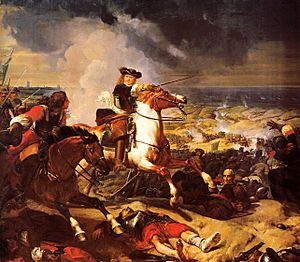
Galerie des Batailles, Palace of Versailles.
In the front, Turenne is on a Skewbald horse.
The war finally ended after Turenne's victory at the Battle of the Dunes near Dunkirk in 1658. A group of experienced English soldiers sent by Cromwell played a key role in this battle. This victory, followed by another successful campaign in 1658, led to the Treaty of the Pyrenees in 1659.
When Mazarin died in 1661, King Louis XIV took full control of the government. One of his first actions was to appoint Turenne "marshal-general of the camps and armies of the king." The king had offered to bring back the old title of Constable of France for Turenne. This would happen if Turenne became a Roman Catholic. Turenne refused. He was born to Calvinist parents and raised as a Protestant. He had refused to marry one of Richelieu's nieces in 1639. He later turned down a similar offer from Mazarin.
In 1652, Turenne married Charlotte de Caumont. She was the daughter of the Protestant Marshal de la Force. He loved her very much. But he truly regretted the split of Christianity into two opposing groups. He had always worried about the influence of many different religious groups. The history of independence in the English army and people greatly affected him. This fear of disorder led Turenne more and more towards the Roman Catholic Church. Letters between him and his wife show how carefully they both studied the issue. In the end, two years after her death, the words of Bossuet and his nephew, the Cardinal de Bouillon, convinced him. He became Catholic in October 1668.
In 1667, he returned to leading the "Camps and Armies of the King." He directed (though Louis XIV was officially in charge) the famous "Promenade militaire." In this, the French easily took over the Spanish Netherlands. Soon after, Condé, who was now friends with the king, had his own success. He quickly conquered the Franche-Comté just before the War of Devolution ended in February 1668.
The Dutch War and Final Campaigns
In Louis XIV's Dutch War of 1672, Turenne joined the army led by the king. This army quickly took over the United Provinces almost up to Amsterdam. The terms Louis offered to the Prince of Orange only made the Dutch fight harder.
The Dutch opened their dikes and flooded the countryside around Amsterdam. This stopped Turenne completely. The king had left him in command. News of this event made Europe react, and the conflict spread to Germany. Turenne fought a successful war of movement on the middle Rhine. Condé protected Alsace.
In January 1673, Turenne attacked. He went deep into Germany and forced the Great Elector of Brandenburg to make peace. Later that year, however, the famous Imperial general Montecuccoli completely outsmarted Turenne. Montecuccoli avoided Turenne, joined the Dutch, and took the important city of Bonn.
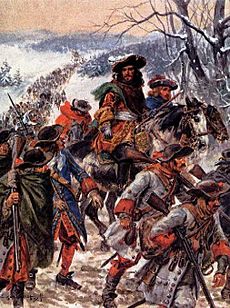
In June 1674, Turenne won the battle of Sinzheim. This made him master of the Electorate of the Palatinate. Following orders from Paris, the French destroyed the country far and wide. This destruction, including the looting of Türckheim, is often seen as the worst stain on Turenne's reputation. In the autumn, the anti-French allies advanced again. They outsmarted Turenne again. The neutral city of Strasbourg allowed the enemy to cross the Rhine there, which led to Turenne's failure.
The battle of Enzheim followed. This was a tactical victory for Turenne, but it did not change the overall situation much. By early December, the allies were still in Alsace. The old marshal then carried out the most daring campaign of his career. He made a fast and secret march in mid-winter from one end of the Vosges mountains to the other. This surprised the allies. Turenne quickly followed up his first successes. He drove the enemy to Turkheim and heavily defeated them there on January 5, 1675. As revenge for the city's strong resistance, Turenne allowed his troops to loot it and kill the remaining people for two weeks. In a few weeks, he had fully recovered Alsace.
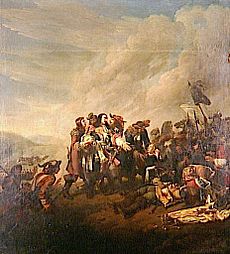
In the summer campaign, he faced Montecuccoli again. After a brilliant display of "strategic chess-moves" by both commanders, Turenne finally forced his opponent to fight at a disadvantage at Salzbach. There, on July 27, 1675, he died from wounds caused by a cannonball. Thomas de Longueville wrote: "Twice he opened his eyes, and then he closed them forever." The news of his death brought sadness everywhere.
Turenne's Legacy
Turenne's most famous countrymen wrote praises about him. Montecuccoli himself said, "A man is dead today who did honor to Man." His body was taken to St Denis and buried with the Kings of France. Even the revolutionaries of 1793 respected him. While they reburied the bodies of the monarchs in a mass grave, they kept Turenne's remains at the Jardin des Plantes. On September 22, 1800, Napoleon had them moved to the church of the Invalides in Paris, where they still rest.
Napoleon told all soldiers to "read and re-read" Turenne's campaigns. He called Turenne one of the great captains of history. He placed him among Alexander the Great, Hannibal, Frederick the Great, Prince Eugene of Savoy, Gustavus Adolphus, and Julius Caesar. Turenne's fame as a general was as great as any other in Europe. People at that time studied war more closely than ever before. His military style showed the art of war of his time.
Turenne was careful in his plans and precise with supplies. He was also brilliant in small fights and stayed strong in both success and failure. These are some of his key strengths as a military leader. He avoided big battles. His own saying was "Few sieges and many combats." Unlike his rival Condé, who was brilliant from his first battle, Turenne improved every day. Napoleon said his genius grew bolder as he got older. Another writer, the Duke of Aumale, wrote: "To know him, you must follow him up to Salzbach. In his case, every day signaled some progress.”
In his personal life, Turenne was a simple and honorable soldier. He was also very tactful. But in politics and intellectual discussions, he seemed almost helpless against a clever plotter or debater. His morals were stricter than those common in his time. He spent his life with his troops. He knew how to earn their affection. He balanced strict discipline with great generosity. His men loved him as a friend as much as they admired him as a commander.
So, even though Condé's genius seemed more varied, Turenne's genius best represents the art of war in the 17th century. For the small, expensive, and highly trained armies, and for the wars of kings in Louis XIV's time, Turenne was the perfect army leader.
During the French Revolution, his reputation as a man of the people meant his tomb was one of the few noble tombs not destroyed. Napoleon considered him the greatest modern commander. Eugene of Savoy, when praised above Turenne, called it disrespectful to Turenne. Turenne is one of the subjects in Morris’s book "Great commanders of modern times." According to Morris, Turenne's "powerful genius" greatly helped shape modern warfare.
Images for kids
-
Turenne's tomb in Les Invalides
-
Statue of Turenne in Versailles
In Fiction
Marshal of France Turenne appears in several alternative history novels by Eric Flint and David Weber. These include 1633 and 1634: The Baltic War. Turenne also appears in a historical novel by G.A. Henty called Won by the Sword.
See also
 In Spanish: Enrique de la Tour d'Auvergne-Bouillon para niños
In Spanish: Enrique de la Tour d'Auvergne-Bouillon para niños


